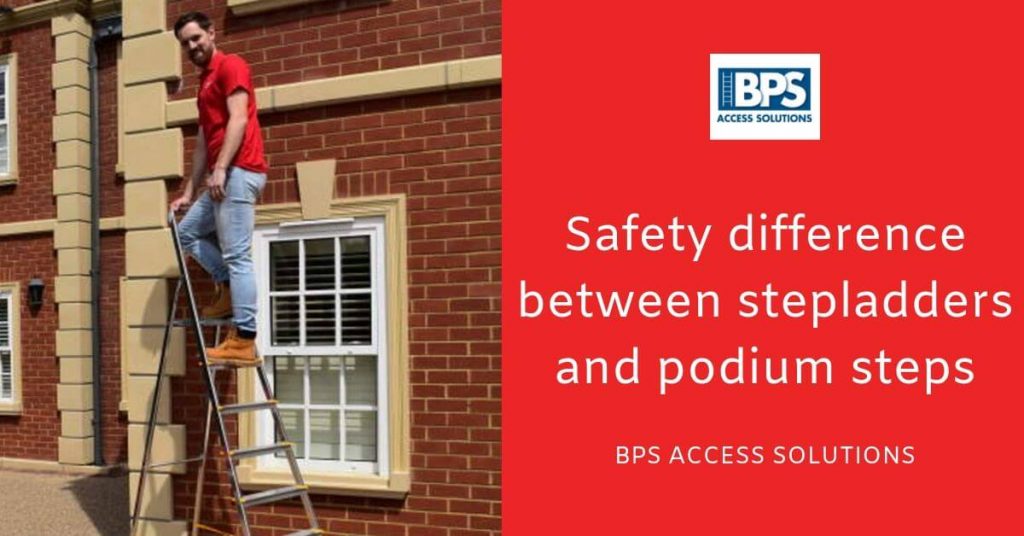What are the safety differences between podium steps and stepladders?
Stepladders and the podium steps are two specialised pieces of equipment which are ideal for use in work environments which require minimal additional height. Both come in a number of different configurations for use in many specific work situations, and both have their own strengths and weaknesses.
When it comes to safety, are stepladders better than podium steps? And what should you be looking for to tell if the stepladder or podium step you are using is up to the job? Below we’ll discuss some of the safety differences between the two and outline which safety features matter most in different situations.
Podium steps can be seen as a smaller version of scaffolding ladders and scaffolding towers
Safety in different situations
Podium steps and stepladders both have their own unique safety features which make them more appropriate for use in different situations. Knowing how each is suited to specific work situations can help you decide which will be safest in your work environment.
Stepladders generally have thinner, less stable frames. This may sound like an obvious flaw, but it makes them highly portable and easy to set up. In an indoor work environment or shop, where a need for additional height can come and go, stepladders are a great choice because of their portability and small profile.
On the other hand, podium steps tend to be much larger structures which are difficult to disassemble. This makes them more difficult to use in work environments where they could stand out as an obstacle.
When it comes to outdoor work environments with a stable, flat floor surface, the additional structural strength offered by a podium step can bring significant benefits. Outdoor work often comes with additional hazards such as nearby machinery or adverse weather conditions. The strengthened frame and enclosed working platform of a podium steps help it protect workers in a way a stepladder simply cannot.
Safety features of the stepladder
Stepladders have been around for a long time. Over the years many additional safety features have been added and refined to make the stepladder as reliable and dependable as possible. American inventor John H. Balsley was the first to patent a folding stepladder design with a hinge and flat steps back in 1862. This was the first iteration of the modern stepladder as we know it today.
The simple design of the stepladder may appear to lack safety features, but this is not the case. Many of its most crucial safety features are things we take for granted. Arguably the most important safety feature on a stepladder is the locking mechanism which keeps the frame in an upright position. Without a lock to keep the frame in place, the stepladder could easily buckle under weight when in use.
The rubber foot attachments found at the bottom of each leg are crucial for providing a firm, secure footing for the ladder and anyone working on it. Although surfaces should always be checked before use, and wet surfaces are less of a risk indoors, foot attachments help ensure the ladder stays firmly in place.
As with all types of ladder, grip surfaces on the rungs help provide a firm footing for users. Again, this may be something we take for granted as an integral feature, but without it there would be a significantly higher risk of injury as a result of a slip.
Safety features of the podium step
Compared to stepladders, podium steps have a much more safety-orientated design. They essentially serve the same purpose as a stepladder in the workplace, but have been redesigned from the bottom-up to be as safe as possible.
The most apparent visible difference between a podium step and a stepladder is the frame. While stepladders consist of a simple hinged frame, podium steps are much more similar to tower scaffolding in their structure. From the firmly-planted, four-legged base, up to the enclosed working platform, the structure of the podium step is significantly reinforced. Metal struts and beams help provide stability for users in a variety of work situations where stepladders are inadequate.
The primary safety feature of the podium step is the enclosed working platform which provides a more stable, protected work space for users. A metal frame encloses the working platform on all sides, allowing workers to handle tools using both hands, without any significant loss of balance. A lack of balance in situations requiring two-handed tool use is one of the main drawbacks of the stepladder.
Another important structural feature included on many podium steps is the additional support struts which can be installed around the base. These work alongside the generally strengthened frame and the enclosed working platform to provide far superior stability for users. This can be crucial when working in situations which require users to reach outwards or upwards.
Which is the safer choice?
Although both the stepladder and podium step are designed to provide users with additional height, the podium step is by far the safer choice. Far superior stability, strength and protection for users make the podium step the logical step up from the stepladder.
Although the stepladder is perfectly adequate for light duty indoor use, it is still falls behind the podium step in pretty much every measure of safety. Where the stepladder does outdo the podium step is cost and portability. The price and impracticality of the podium step for quick use mean that the stepladder is often the easier choice and as long as guidelines are followed, stepladders are perfectly safe.
If you would like to know more about stepladders and podium step, or need further equipment recommendations, please get in touch with us.
No related posts.



